Please note that our FAQs pages are informational in nature and should not be relied upon in lieu of proper training. If you have a question not covered on these pages, please contact us by phone.
January 19, 2016, 11:03 am | Question from Ed | Category: Fall Protection Systems
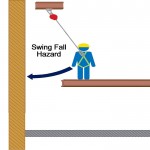 Swing fall is the distance a worker will swing back to the center of the anchor point during a fall. This distance is created when a worker moves away from the anchor point of a fall protection system. In most cases when a worker falls, he or she will swing past the anchor point, and depending on the how far they have moved away from it or how great the swing distance is, it might be enough to cause them to hit the surface below or adjacent to them. Read more.
Swing fall is the distance a worker will swing back to the center of the anchor point during a fall. This distance is created when a worker moves away from the anchor point of a fall protection system. In most cases when a worker falls, he or she will swing past the anchor point, and depending on the how far they have moved away from it or how great the swing distance is, it might be enough to cause them to hit the surface below or adjacent to them. Read more.
January 18, 2016, 10:22 am | Question from Jason | Category: Guardrails & Skylights
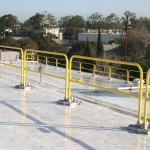 Active fall protection requires special equipment, participation and training on the part of the user (i.e., if the worker needs a harness, it is an “active” system). It is generally used in a situation where a worker requires a fall arrest system to arrest or stop their fall. Read more.
Active fall protection requires special equipment, participation and training on the part of the user (i.e., if the worker needs a harness, it is an “active” system). It is generally used in a situation where a worker requires a fall arrest system to arrest or stop their fall. Read more.
January 14, 2016, 3:32 am | Question from Robert | Category: Fall Protection Systems
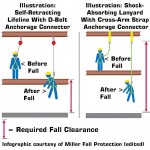 Simple; how far do you want to fall? Most common self-retracting lifelines have a fall clearance of 6-½ feet. Some newer personal fall limiters (a smaller SRL) have reduced that to 5 feet; however, lanyards have a drastically greater fall clearance at 18-½ feet. Read more.
Simple; how far do you want to fall? Most common self-retracting lifelines have a fall clearance of 6-½ feet. Some newer personal fall limiters (a smaller SRL) have reduced that to 5 feet; however, lanyards have a drastically greater fall clearance at 18-½ feet. Read more.
January 13, 2016, 3:57 am | Question from George | Category: Services & Installation
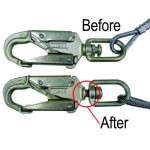 Fall protection equipment inspections are mandated by OSHA to be performed after a fall of any kind. All equipment would need to be taken out of service and inspected and repaired before returning it to service. Read more.
Fall protection equipment inspections are mandated by OSHA to be performed after a fall of any kind. All equipment would need to be taken out of service and inspected and repaired before returning it to service. Read more.
January 6, 2016, 9:44 am | Question from James | Category: Fall Protection Training
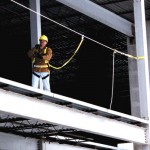 OSHA mandates two different height requirements, because after 4 feet or 6 feet, injuries from a fall become both disabling and fatal. At a height of 4 feet, injuries can be so great that they can cause severe disability and functional incapacitation. Read more.
OSHA mandates two different height requirements, because after 4 feet or 6 feet, injuries from a fall become both disabling and fatal. At a height of 4 feet, injuries can be so great that they can cause severe disability and functional incapacitation. Read more.
January 4, 2016, 9:09 am | Question from David | Category: Services & Installation
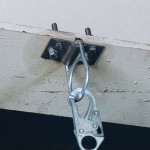 Non-certified anchor points need to withstand a 5000-lb. force. Certified anchor points, on the other hand, which are generally signed off on by a fall protection engineer, are capable of withstanding two times the maximum arresting force for the deployment of the fall protection system. Read more.
Non-certified anchor points need to withstand a 5000-lb. force. Certified anchor points, on the other hand, which are generally signed off on by a fall protection engineer, are capable of withstanding two times the maximum arresting force for the deployment of the fall protection system. Read more.
January 3, 2015, 10:43 am | Question from Don | Category: Fall Protection Systems
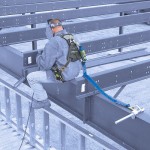 Fall protection equipment, and specifically, harnesses, have benefited from tremendous advances in technology in recent years. Materials now available allow us to offer a large variety of harnesses, including those with thermal protection for welders and iron workers that ensure harness integrity should spark or welding spat fly onto them. Read more.
Fall protection equipment, and specifically, harnesses, have benefited from tremendous advances in technology in recent years. Materials now available allow us to offer a large variety of harnesses, including those with thermal protection for welders and iron workers that ensure harness integrity should spark or welding spat fly onto them. Read more.
 Swing fall is the distance a worker will swing back to the center of the anchor point during a fall. This distance is created when a worker moves away from the anchor point of a fall protection system. In most cases when a worker falls, he or she will swing past the anchor point, and depending on the how far they have moved away from it or how great the swing distance is, it might be enough to cause them to hit the surface below or adjacent to them. Read more.
Swing fall is the distance a worker will swing back to the center of the anchor point during a fall. This distance is created when a worker moves away from the anchor point of a fall protection system. In most cases when a worker falls, he or she will swing past the anchor point, and depending on the how far they have moved away from it or how great the swing distance is, it might be enough to cause them to hit the surface below or adjacent to them. Read more.






